2016-01-02 By Robbin Laird, Ed Timperlake and Murielle Delaporte
As former Chief of Staff of the USAF “Buzz” Mosley once stated about the USAF:
“There is not a place on the face of the earth that the USAF will not fight their way into.”
This core objective has been challenged by the combat learning, training and operations for nearly decade of combat with significant expenditures in counter-insurgency.
Skill sets for technology and training for U.S. Air and Naval forces for National Defense embracing offensive global power projection have atrophied. Land combat focused budgeting priorities have been prioritized for slow motion “human terrain mapping” Counter insurgency focused nation building operations.
There is an intellectual COIN cult, which has come to dominate the Department of Defense and allied Ministries of Defense based on the Iraq/Afghanistan military experience of the past decade of operations.
Publics used to hearing about large defense investments in the past decade can be excused for confusing defense expenditures for land operations with a shortfall in investments in Air/Sea power projection.
Things are changing dramatically with a resurgent Russia and an increasingly geo-politically aggressive China.
Fortunately the USAF, RAF and French Air Force have come together to develop jointly accepted air combat con-ops.
A combat exercise recently held at Langley Air Force Base with the high end air combat capabilities of the USAF, the Royal Air Force (RAF) and the French Air Force (FAF) was about recovering lost or diminishing skill sets, honing new ones, and shaping a template for the 21st century transformation of their respective nations air combat force.
The origins of the trilateral exercise came from agreements reached reached five years ago by the three nations and the three air forces.
The exercise at Langley was the flying confirmation of the bold commitment to reshape the capabilities of the three air forces in fighting high-end warfare.
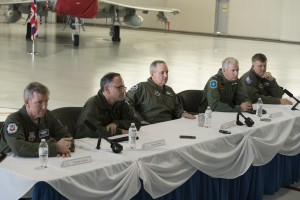
And with the events unfolding in the Middle East, and with a peer competitor firmly entrenched at a new airbase in Syria, the challenge of contested airspace is not an abstraction, but a real world reality. And this was something which the Turkish-Russian exchange reinforced in the minds of pilots, and decision makers from the current conflict.
The close relationship to the real world and the exercise was highlighted in a remark made by Chief of Staff Mark Welsh at the Media Day held during on the exercise on December 15, 2015.
“Interoperability among allies, and deconfliction in the operations of air forces in close proximity is crucial. We are using the same communications processes in the exercise that we are currently using in the Middle East to provide for interoperability and deconfliction.”
But while the real world was hovering over the event, what the three air forces were working on was shaping a template for 21st century operations within which fifth generation capabilities were being blended with the rest of the air combat force to create a more lethal, survivability and effective 21st century combat force.
This was a pull exercise in which a fifth generated enabled force was being shaped, in which the core capabilities of the Typhoon and Rafale were being leveraged to shape a more capable air combat force.
The F-22 was ending publically its period of looking like an orphan; and although the F-22 has flown with Typhoon in the past, this was the first time flying with the Rafale.
As Hawk Carlisle put it: “The whole is greater than the sum of the parts and we are working in this exercise in shaping a more effective force.”
The changing threat environment was highlighted by the senior Air Force officers present at the media day event. All of the speakers — USAF Chief Mark Welsh, ACC Commander Hawk Carlisle, USAFE Chief General Frank Gorenc, RAF Chief Sir Andrew Pulford, and General Antoine Crux, Inspector General of the French Armed Forces representing the Chief of Staff of the FrAF – commented on the evolving threat environment, which was perhaps the only topic on which all five provided comments.
The threat environment was largely discussed in terms of contested air space.
The environment is seen as one in which U.S. and allied forces would have an increasingly difficult time to operate to support broader military operations.
The threat was characterized variously as anti-access, area denial, or multi-spectrum threats, or simply adversaries enhancing their capabilities. General Hawk Carlisle put it in terms of a multi-spectrum environment shaping a new threat envelope.
“In this exercise in particular we are focused on enemy aircraft and their missiles, surface to air missiles, and electronic warfare as evolving adversarial threats.”
Carlisle then went on to note that during the exercise “we are focusing on link architecture and communications to pass information, the contributions the different avionics and sensor suites on the three aircraft can contribute to the fight, the ability to switch among missions, notably air-to-air and air-to-ground and how best to support the fight, for it is important to support the planes at the point of attack, not just show up.”
In other words, the dynamic change in how high end aircraft were working together was the crucial point of the exercise.
One key difference from the past is the role of the AWACs.
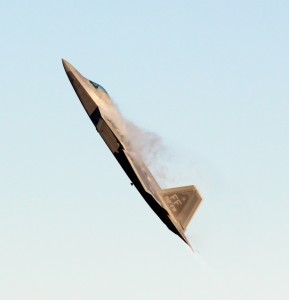
If this exercise was held 12 years ago, not only would the planes have been different but so would the AWACS role. The AWACS would have worked with the fighters to sort out combat space and lanes of operation in a hub spoke manner.
With the F-22 and the coming F-35, horizontal communication among the air combat force is facilitated so that the planes at the point of attack can provide a much more dynamic targeting capability against the adversary with push back to AWACS as important as directed air operations from the AWACS.
As General Hawk Carlisle put it:
“The exercise was not about shaping a lowest common denominator coalition force but one able to fight more effectively at the higher end as a dominant air combat force.
The pilots learning to work together to execute evolving capabilities are crucial to mission success in contested air space.”
Modernization of assets, enhanced capabilities to work together and shaping innovative concepts of operations were seen as key tools for the U.S. and the allies to operate in the expanded battlespace in order to prevail.
It is an ongoing challenge, which required the air forces to shape relevant skill sets.
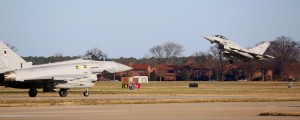
The skill set theme was especially highlighted by the head of the RAF. Sir Andrew Pulford noted that as the RAF added two additional Typhoon squadrons and an additional F-35 squadron, he was concerned to shape the right skill sets going forward into a world in which a benign environment for air operations would not be the norm.
The Typhoon is a very lethal combat asset, which is leading the RAF attacks against ISIS in the Middle East with the Typhoon-Tornado tandem as a key part of the force package.
Typhoon modernization is adding to the lethality and survivability of Typhoon and will make it even a more valuable member of any air combat coalition.
According to Group Captain Paul Godfrey, the air boss of RAF Lossiemouth:
“The modernization of Typhoon is underway and we have seen real progress in terms of electronic warfare, sensors and integration, and improvements in the human machine interface which is going to make the cockpit more effective to operate the aircraft in the expanded battlespace with 5th gen assets.”
The Rafale is the oldest of the three fighters in the core air combat air force in the exercise.
The plane has seen significant combat experience in Africa and the Middle East and Afghanistan.
It is the key enabler of the French force approach to joint and expeditionary operations, and over time the combat systems on the aircraft have seen significant modernization.
Fifteen years have passed since the first Rafale entered in service in the French Navy.
“We started very small with a fleet of only ten aircraft up until 2004”, recalls Marie-Astrid Vernier,, who at the time of the June 2014 interview was head of military support at Dassault Aviation and who has worked on the Rafale since 1994.
The current French Rafale fleet has been built with the delivery of four different “tranches” of aircraft which have been upgraded over the years into various standards, the latest one being the Standard F3R to be delivered in 2018.
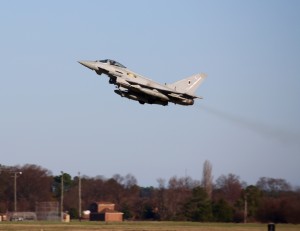
Today’s Rafale F3 has little to do with the very first F1: “Retrofitting the very first planes from a F1 standard to a F3 standard takes far more time than upgrading later-built planes”, explains Capitaine de Vaisseau Sébastien Fabre, formerly in charge of the support of the Rafale fleet within the French MoD.
As the thousandth modification was achieved in 2014, the latter stressed in an interview that “60% of these changes relate to standard and technical tracking, while the rest has to do with improving equipment and support tools”.
Today’s 2015 Rafale is a rather different bird from the 2000’s Rafale, as new technologies allowed for new operational missions, which in turn drove new technical requirements.
The convergence of the RAF and the FAF onto Langley to work with the USAF bringing their top tip of the spear forces – Typhoons and Rafales – to fly with the F-22 was itself a work in progress on expeditionary airpower.
But the tip of the spear is only that without the expeditionary support provided by the entire combat force.
The mere ability to cross the Atlantic and train together is already an achievement on its own.
Preparing the support of such a large-scale exercise is also something both the RAF and the French Air Force are accustomed to thanks to exercises regularly hosted by the USAF, such as Red Flag.
What was different however was the way it was done in a joint manner between the two European Air Forces and was considered as such by many participants as an “expeditionary opportunity” on its own.
All French personnel (about 110) –- besides the fighters and KC-135s pilots –- were flown first from France to the UK with French transport means, but then were taken onboard British C17 and KC-30A Voyager (British A330 MRTT).
In short, the exercise is a beginning effort during which the air chiefs emphasized they would continue and perhaps accelerate the efforts in air force combat transition.
“Whoever can gather, process and exploit the most information in the quickest time will win the information war and ultimately the fight.
With fifth generation aircraft being able to instantly share data with their fourth generation cousins, the Typhoon can become and an even more effective and capable jet fighter.”
http://www.raf.mod.uk/news/archive/trilateral-agreement-gets-airborne-17122015
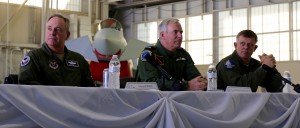
Perhaps the best capstone comment on the exercise was provided by the head of the RAF, Sir Andrew Pulford:
“The important thing is our three air forces can operate together as one.
The three air forces are demonstrating that we can and always have worked well together, that we still can and still do, and it doesn’t matter whether we are operating over Iraq or Syria, or exercising here on the east coast of the U.S., these are three air forces operating as one team and for the common good.”
Editor’s Note: A version of this article was first published on Breaking Defense.
It should be noted that the three air forces are the members of NATO which are nuclear powers.
And at least one of them explicitly discusses its nuclear role.
Early last year, President Hollande visited a key French Air Force base and discussed the importance of their role in nuclear deterrence.
And the current ACT Commander, General Mercier, when Commander of the French Air Force, highlighted that the C2 system and air force modernization was especially important given the role of the Air Force in nuclear deterrence.
For earlier pieces published on the Trialteral Exercise and related background pieces, see the following:
http://operationnels.com/2015/12/17/trilateral-exercise-2015-access-project-and-sustain-jointly/
https://sldinfo.com/the-trilateral-exercise-the-latest-product-of-the-2010-trilateral-agreement/
https://sldinfo.com/the-planes-in-the-trilateral-exercise/
https://sldinfo.com/the-royal-air-force-participates-in-the-trilateral-exercise/
https://sldinfo.com/raf-typhoons-in-the-trilateral-exercise/
https://sldinfo.com/xi-squadron-in-the-trilateral-exercise/
https://sldinfo.com/raf-pilot-discusses-the-trilateral-exercise/
https://sldinfo.com/general-hawk-carlisle-on-the-way-ahead-for-airpower/
https://sldinfo.com/the-re-norming-of-airpower-in-practice-an-f-22-enabled-air-combat-force/
https://sldinfo.com/the-renorming-of-airpower-in-practice-the-f-22-leads-the-way/

